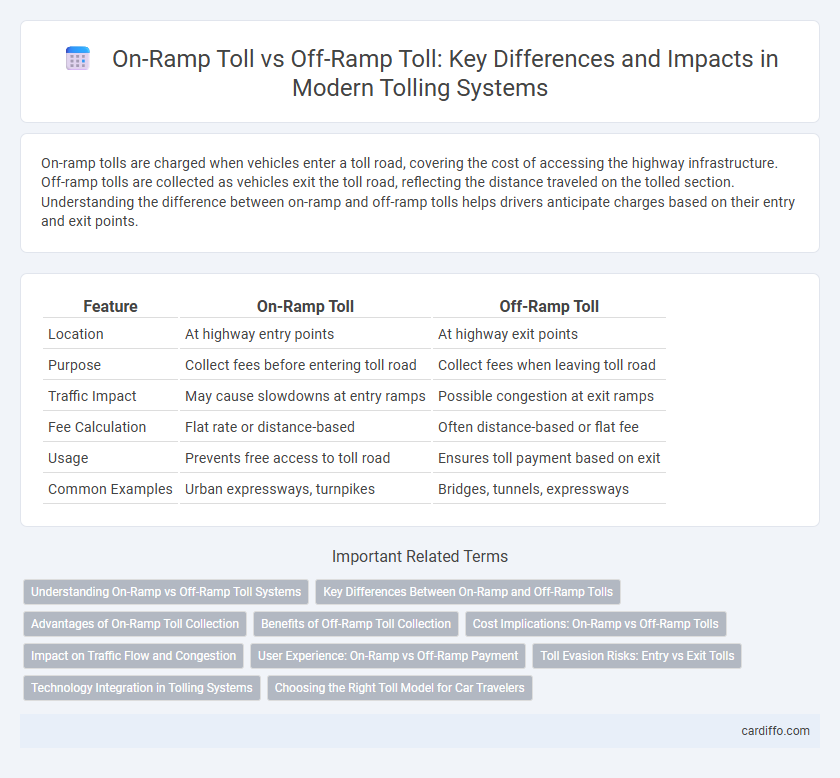On-ramp tolls are charged when vehicles enter a toll road, covering the cost of accessing the highway infrastructure. Off-ramp tolls are collected as vehicles exit the toll road, reflecting the distance traveled on the tolled section. Understanding the difference between on-ramp and off-ramp tolls helps drivers anticipate charges based on their entry and exit points.
Table of Comparison
| Feature | On-Ramp Toll | Off-Ramp Toll |
|---|---|---|
| Location | At highway entry points | At highway exit points |
| Purpose | Collect fees before entering toll road | Collect fees when leaving toll road |
| Traffic Impact | May cause slowdowns at entry ramps | Possible congestion at exit ramps |
| Fee Calculation | Flat rate or distance-based | Often distance-based or flat fee |
| Usage | Prevents free access to toll road | Ensures toll payment based on exit |
| Common Examples | Urban expressways, turnpikes | Bridges, tunnels, expressways |
Understanding On-Ramp vs Off-Ramp Toll Systems
On-ramp toll systems charge vehicles as they enter a toll road, ensuring payment is collected based on access points, while off-ramp toll systems collect fees when vehicles exit, allowing toll rates to reflect distance traveled. Understanding the difference between on-ramp and off-ramp toll systems is essential for optimizing traffic flow and minimizing congestion at toll plazas. Accurate toll collection technology and data integration enhance revenue management and improve driver experience across both systems.
Key Differences Between On-Ramp and Off-Ramp Tolls
On-ramp tolls are charges applied when entering a toll road, designed to regulate access and manage traffic flow, while off-ramp tolls are collected when exiting, often used to fund maintenance for connecting local roads. On-ramp tolls are typically fixed or distance-based fees, whereas off-ramp tolls may vary depending on exit locations and road usage patterns. The key distinction lies in their placement and purpose: on-ramp tolls control entry costs while off-ramp tolls allocate expenses related to exit infrastructure and local road support.
Advantages of On-Ramp Toll Collection
On-ramp toll collection enhances traffic flow efficiency by capturing fees as vehicles enter the highway, reducing congestion at exits and mainline toll plazas. This method improves revenue accuracy by targeting toll payments based on entry point usage, facilitating better traffic management and maintenance funding. On-ramp toll systems also lower operational costs through streamlined tolling infrastructure and minimize delays compared to traditional off-ramp toll collection.
Benefits of Off-Ramp Toll Collection
Off-ramp toll collection streamlines traffic flow by reducing congestion at mainline toll plazas, enabling smoother and faster commutes for drivers. This system enhances revenue accuracy through location-specific tolling based on actual exit usage, minimizing toll evasion and improving cost recovery. Off-ramp tolling also supports better infrastructure funding allocation by linking toll revenues directly to the roads frequently accessed by travelers.
Cost Implications: On-Ramp vs Off-Ramp Tolls
On-ramp tolls typically incur charges when vehicles enter a toll road, while off-ramp tolls apply upon exiting, each affecting overall travel costs differently. On-ramp tolling usually results in fixed fees based on entry points, whereas off-ramp tolls may vary depending on the specific exit and distance traveled. Understanding the cost implications of on-ramp versus off-ramp tolls helps drivers optimize expenses by choosing entry and exit points strategically.
Impact on Traffic Flow and Congestion
On-ramp tolls help regulate the volume of vehicles entering highways, reducing merging conflicts and smoothing traffic flow, which decreases congestion at entry points. Off-ramp tolls primarily manage exit demand, potentially causing localized slowdowns but relieving mainline traffic pressure by discouraging unnecessary exits. Implementing on-ramp tolls often results in more efficient overall highway performance compared to off-ramp tolls, as controlling entry points directly influences upstream traffic density and congestion.
User Experience: On-Ramp vs Off-Ramp Payment
On-ramp toll payment enhances user experience by allowing drivers to pay as they enter the highway, reducing stoppage and maintaining traffic flow. Off-ramp tolls may cause congestion as vehicles slow down or stop to pay after traveling, impacting overall trip efficiency. Electronic toll collection systems improve both methods but prove more effective on on-ramps for seamless, uninterrupted travel.
Toll Evasion Risks: Entry vs Exit Tolls
On-ramp tolls primarily pose toll evasion risks at entry points, where drivers might bypass toll collection by avoiding designated toll plazas. Off-ramp tolls shift the evasion risk to exit points, as vehicles may exit without paying if toll barriers or enforcement are insufficient. Effective toll enforcement systems, including electronic toll collection and cameras, are critical to minimizing evasion at both entry and exit toll locations.
Technology Integration in Tolling Systems
On-ramp tolls utilize advanced sensor technology and real-time data processing to manage vehicle entry smoothly, minimizing congestion and enhancing traffic flow. Off-ramp tolls integrate license plate recognition and automated billing systems to accurately charge drivers upon exit without disrupting travel. Both toll types leverage integrated GPS and mobile payment platforms, ensuring seamless toll collection and improved user convenience across transportation networks.
Choosing the Right Toll Model for Car Travelers
Choosing the right toll model for car travelers depends on traffic patterns and convenience; on-ramp tolls charge vehicles when entering highways, effectively managing congestion at entry points. Off-ramp tolls apply fees upon highway exit, distributing toll collection and potentially reducing entry delays. Evaluating travel routes and peak usage times helps determine which toll type minimizes costs and maximizes traffic flow efficiency.
On-Ramp Toll vs Off-Ramp Toll Infographic

 cardiffo.com
cardiffo.com